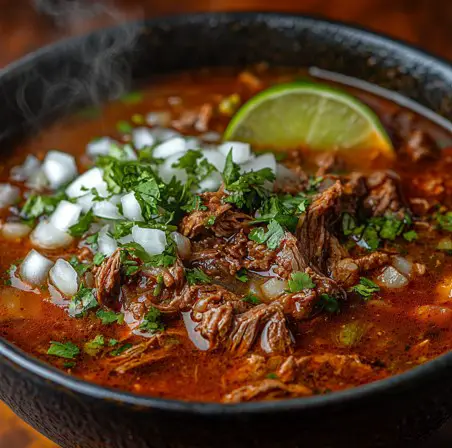Birria is a traditional Mexican dish known for its rich and flavorful stew, typically made with goat meat, though beef and lamb are also popular alternatives. Originating from the state of Jalisco, birria has deep roots in Mexican culture and cuisine, often prepared for special occasions such as weddings and holidays. The dish is characterized by its slow-cooked, marinated meat combined with a complex blend of spices, resulting in a savory and aromatic meal that has gained international recognition.
Brief Definition and Origin
Birria is derived from the word “birria,” which means “exquisite savory dish” in Spanish, reflecting the dish’s esteemed place in Mexican culinary traditions. It was originally a way to make use of tough meat cuts by marinating them in a mixture of chiles and spices and then slow-cooking until tender. This cooking method transforms the meat into a succulent and flavorful stew.
Importance in Mexican Culture and Cuisine
Birria holds a significant place in Mexican culture, especially in regions like Jalisco, where it is a culinary staple. The dish is not only enjoyed in everyday meals but also plays a central role in celebrations and gatherings. Its preparation and consumption are often communal activities, reinforcing the sense of community and tradition. With its robust flavors and cultural significance, birria is a true representation of the richness of Mexican cuisine.
Ingredients and Preparation
Key Ingredients
- Types of Meat Traditionally Used
- Goat: The most traditional meat for birria, especially in Jalisco, known for its tenderness and unique flavor after slow cooking.
- Beef: A popular alternative, especially outside of Mexico, often used for its availability and milder taste.
- Lamb: Another traditional option, offering a rich and slightly gamey flavor.
- List of Spices and Their Significance
- Guajillo Chiles: Key to the adobo sauce, providing a mild heat and deep red color.
- Cumin: Adds earthiness and warmth, a staple in Mexican spice blends.
- Garlic: Essential for depth and aroma, used generously in the marinade and cooking.
- Other Essential Ingredients
- Vinegar: Used in the marinade to tenderize the meat and add acidity.
- Tomatoes: Provide a sweet, tangy base for the sauce, balancing the spices.
Preparation Process
- Marinating the Meat
- The meat is marinated in a rich adobo sauce made from a blend of chiles, garlic, vinegar, and spices. This step is crucial for infusing the meat with flavor and tenderizing it.
- Making the Adobo Sauce
- The sauce is prepared by blending soaked chiles, tomatoes, garlic, and spices into a smooth paste. This paste is often cooked briefly to enhance the flavors before marinating the meat.
- Slow-Cooking Methods
- Oven: Traditional method where the marinated meat is slow-cooked in a sealed pot until tender.
- Stovetop: Simmering the meat over low heat in a heavy pot to achieve the same tender texture.
- Instant Pot: A modern adaptation, significantly reducing cooking time while maintaining flavor and tenderness.
Regional Variations
- Different Styles Across Regions
- Tijuana-Style Birria: Typically made with beef, this version is often grilled before being served in tacos, giving it a distinct smoky flavor.
- Zacatecas Variation: Known for using lamb and a slightly different spice blend, this version is often less spicy and more herbaceous.
- Differences in Ingredients and Cooking Methods
- The type of meat and specific spices can vary significantly by region, reflecting local tastes and available ingredients. Some regions might include additional herbs like bay leaves or cloves, while others may adjust the level of heat by varying the types of chiles used. Cooking methods also vary, with some regions favoring traditional clay pots or even outdoor pit cooking for an authentic experience.
Serving and Eating Birria
Traditional Serving Style
Birria is traditionally served as a rich, flavorful stew or consommé, where the tender meat is submerged in a deep, savory broth. This broth is often a byproduct of the slow-cooking process, capturing the essence of the meat and spices. It is typically accompanied by fresh, handmade corn tortillas, which are used to scoop up the meat and soak up the broth. Additional accompaniments often include lime wedges for a burst of acidity, finely chopped onions for crunch, and cilantro for a fresh, herbal note.
Birria Tacos
Birria has become increasingly popular as a filling for tacos, particularly in the form of birria tacos, where the meat is shredded and placed inside a tortilla, often dipped in the birria broth before being grilled to crispy perfection. Another popular variation is the birria quesatacos, which involves adding a layer of melted cheese inside the taco, creating a gooey, flavorful fusion of cheese and birria. The tacos are typically served with a side of consommé for dipping, enhancing the flavors even further.
Popular Garnishes
The enjoyment of birria, whether as a stew or in tacos, is often elevated by the addition of simple yet flavorful garnishes. Common garnishes include:
- Cilantro: Adds a fresh, herbal brightness.
- Onion: Provides a sharp, crunchy contrast.
- Lime: Offers acidity that cuts through the richness of the meat.
- Radishes: Introduce a peppery crunch that complements the overall dish.
Health Considerations
Nutritional Information
Birria is a hearty dish, typically rich in calories due to its high protein and fat content. The caloric content can vary depending on the meat used, with goat and lamb being slightly leaner than beef. A typical serving may provide a substantial amount of protein, moderate fats, and minimal carbohydrates. Key ingredients like chiles and garlic offer health benefits; chiles are rich in vitamins A and C and capsaicin, while garlic is known for its anti-inflammatory and immune-boosting properties.
Potential Dietary Restrictions
- Adaptations for Various Diets:
- Gluten-Free: Birria is naturally gluten-free when served traditionally.
- Low-Fat: Use leaner cuts of meat or trim excess fat to reduce the dish’s fat content.
- Vegetarian and Vegan Alternatives:
- Substitute meat with mushrooms, jackfruit, or plant-based meat alternatives to create a vegetarian or vegan version. These alternatives can be marinated and cooked in the same way to replicate the rich, flavorful experience of traditional birria while accommodating dietary preferences.
Birria’s Growing Popularity and Global Influence
Rise in Popularity
In recent years, birria has seen a meteoric rise in popularity across the globe, particularly in North America. This trend has been fueled by the power of social media platforms like Instagram and TikTok, where users share videos and photos of the vibrant, mouthwatering dish. Food trucks have also played a significant role, bringing birria to urban areas and introducing it to a broader audience. The visually appealing nature of birria tacos, especially when dipped in consommé, has made them a viral sensation.
Fusion Cuisine
The global influence of birria has led to creative culinary innovations and fusion dishes. A notable example is birria ramen, where the rich birria broth is combined with noodles, blending Mexican and Japanese flavors in a unique and satisfying way. Birria has also been incorporated into other fusion dishes like birria pizza, birria grilled cheese, and birria quesadillas, demonstrating its versatility and appeal.
Influence on Global Cuisine and Adaptations
Birria’s popularity has prompted adaptations beyond its traditional form, with chefs worldwide experimenting with local ingredients and techniques. This has resulted in variations that retain the essence of birria while incorporating elements from different cuisines, further solidifying its place as a beloved dish on the global culinary stage.
FAQs About Birria
What is the best meat for birria?
Traditionally, birria is made with goat meat, but beef and lamb are also popular options, especially outside of Mexico. Each meat provides a different flavor profile, with goat offering a slightly gamey taste and beef providing a milder, more universally appealing flavor.
Can birria be made in an instant pot?
Yes, birria can be made in an instant pot, which significantly reduces the cooking time while still yielding tender, flavorful meat and broth.
What’s the difference between birria and barbacoa?
Birria is a spiced stew often served in broth, while barbacoa is typically slow-cooked meat, traditionally prepared in a pit, and served without broth. The seasoning profiles and cooking methods also differ.
How do you store and reheat birria?
Birria can be stored in an airtight container in the refrigerator for up to 4 days. To reheat, warm it gently on the stovetop or in a microwave, adding a bit of water or broth if needed.
Is birria spicy?
Birria can be spicy, depending on the type and amount of chiles used in the recipe. However, the level of heat can be adjusted to suit personal preferences.
Conclusion
Recap of Birria’s Significance
Birria is a cherished dish in Mexican cuisine, renowned for its rich, flavorful broth and tender meat, often enjoyed during special occasions. Its deep cultural roots and traditional preparation methods reflect the heritage and culinary diversity of Mexico, making it a symbol of communal and festive gatherings.
Final Thoughts
Whether you’re cooking it at home or trying it from a local eatery, birria offers an unforgettable taste experience. With its rising popularity worldwide, there’s no better time to explore this iconic dish and savor its authentic flavors.

Birria
Description
Birria is a traditional Mexican stew that is deeply flavorful and aromatic, often made with goat, beef, or lamb. This dish is slow-cooked to perfection, resulting in tender meat that is infused with a complex blend of chiles, spices, and herbs. Birria can be served as a stew or used as a filling for tacos, especially popular as birria tacos, which are often dipped in the savory broth.
Ingredients
Beef Birria (Birria de Rez)
- 4 pounds beef chuck roast, cut into 3-inch chunks
Birria Sauce
- 10 guajillo chiles
- 5 ancho chilies
- 3 arbol chilies
- 2 Roma tomatoes
- 1 white onion, quartered
- 6 garlic cloves, unpeeled
- 2 cups low-sodium beef broth
- 2 tablespoons apple cider vinegar
- 2 teaspoons kosher salt
- 1 teaspoon ground black pepper
- 1 teaspoon ground cumin
- 1 teaspoon dried Mexican oregano
- ½ teaspoon ground cloves
- ½ teaspoon ground cinnamon
- ¼ teaspoon ground ginger
- 3 bay leaves
- Optional: chopped onion, cilantro, and lime wedges for serving.
Instructions
- Deseed the chilies. Slice the stems off the chilies and shake out the seeds. Then, give them a quick rinse to remove any dust or dirt from the outside.
-
Simmer the chilies. In a medium pot, add the guajillo chilies, ancho chilies, arbol chilies. Cover completely with water and bring to a simmer over medium heat. Simmer for 15 minutes, until the chilies have softened.
- Roast the veggies. While the chilies are simmering, add the tomatoes, onion, and garlic cloves to a quarter sheet pan. Broil them for 4 to 6 minutes, until lightly charred.
- Make the sauce. Transfer the chilies and 1 cup of the remaining water to a high-powered blender. Remove the garlic from it’s peel and add it to the blender along with the tomatoes, onion, broth, vinegar, cumin, oregano, cloves, cinnamon, and ginger. Blend on high for 1 to 2 minutes, until completely smooth.
- Slow cook the birria. Place the beef chunks in the slow cooker. Pour the birria sauce on top, and add the bay leaves. Use tongs to gently mix it all together. then cover. Cook on low for 8 to 9 hours, or on high for 4 to 5 hours. The beef should be tender and fall apart easily when shredded with a fork. If it doesn’t shred easily, cook it a bit longer.
- Shred the meat. Discard the bay leaves. Remove the beef to a cutting board and use two forks to shred it.
- Combine the meat and sauce. Place the shredded beef back in the slow cooker, give it a stir, and let it absorb the liquid (aka consommé).
- Serve. Serve the birria straight from the slow cooker for a variety of meals (see ideas above) or transfer to bowls with the consommé for a traditional birria stew. Garnish with chopped onion, fresh cilantro, and a squeeze of lime juice.
Notes
- Adjusting Spice Level: The heat of the birria can be modified by varying the types and quantity of chiles used. For a milder version, reduce the number of guajillo chiles.
- Serving Suggestions: Serve birria with warm corn tortillas, fresh lime wedges, chopped onions, and cilantro for a traditional experience.
- Cooking Tip: For an even richer flavor, marinate the meat overnight before slow-cooking.
- Instant Pot Option: If you’re short on time, an Instant Pot can be used to cook the birria, significantly reducing the cooking time while maintaining the dish’s signature tenderness.










The flavor was incredible! I had planned to make this and eat it traditionally as a stew and then use some leftovers to make tacos later in the week. However, once it was cooked and I shredded the meat and added it back, it was definitely not a stew consistency, more like a pulled pork consistency. I added quite a bit more broth to make it a soup and let it go on low for 30 minutes to heat up and it tasted perfect!
★★★★